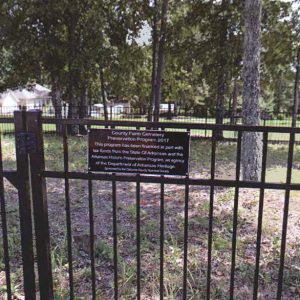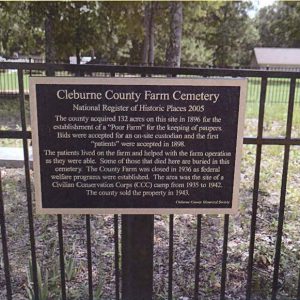calsfoundation@cals.org
Cleburne County Farm Cemetery
The Cleburne County Farm Cemetery, which contains seventeen graves, is located approximately three miles south of Heber Springs (Cleburne County) at the southwestern corner of Plantation Drive East and Deer Run Cove. It is the only remaining physical on-site reminder of the Cleburne County Farm, established in the final years of the nineteenth century for the care of the poor. It was added to the National Register of Historic Places on September 28, 2005.
During the early history of the United States, the ever-growing population of poor citizens was regarded as a danger by many but was seen as a call to service by others. Many citizens and charitable organizations provided services to the poor, as did many local municipalities.
By the second half of the nineteenth century, the poorhouse system, first established in England, took root in the United States. Under this system, local governments established a place, many times a farm complex, where the poor could be housed and provided services.
Though many Arkansas counties did not maintain a poorhouse, many believed that each county had an obligation to address the issue of the poor. In 1896, a commission appointed by Cleburne County Judge J. S. Wilson had located a suitable plot of land for a poor farm. By early 1898, the custodian’s main house was in place and a bid submitted by W. H. Bickle for custodian had been accepted. Bickle was contracted at the rate of $7.50 a month to properly care for the “patients” (the name applied to the tenants) and to keep the farm in good repair. Several men and at least one woman, Viola Clark, in the 1920s served as custodian.
By 1930, the farm had been expanded to include not only the main house but also a new two-room boarding house for the tenants (which was separated by gender), a smokehouse, a barn, a cellar, a chicken house, and proper outhouses. The facility was a completely operational farm with livestock and gardens. All work was completed by the custodian and the tenants. Burial for tenants of the farm was provided in the onsite cemetery.
When the state and county began to receive federal money for the relief of individuals under the New Deal in the 1930s, the need for a county farm slowly decreased. By this time, the farm was home to only two tenants. The main house was destroyed by fire in 1936 and the farm was closed shortly afterward.
In June 1935, Civilian Conservation Corps Camp No. 3782, locally known as Camp Heber, was under construction at the farm site. The camp remained open until 1942. In May 1943, the county government determined that the deteriorating farm structures had outlived their usefulness and decided to sell the property.
The county advertised the property for sale, and Leroy Heigle purchased it for $2,125 on May 10, 1943. Shortly after the sale, the buildings were removed, with the land remaining vacant for about fifty years. In the 1990s, much of the property of the former poor farm was taken over by a housing development. All that remains of the poor farm is the tenant cemetery.
The cemetery is enclosed by a wood and wire fence installed in about 1982 by the Cleburne County Historical Society. That same year, the society cleared the area of underbrush and dedicated a granite marker identifying the seventeen former tenants buried at the site. Though none of the graves are marked by name-engraved headstones, ten of the gravesites are marked by crude fieldstones. While the rural site was abandoned by the mid-1940s, the area has seen residential development in the twenty-first century. The cemetery, however, does not seem to be in any immediate danger of losing its integrity.
For additional information:
Berry, Evalena. Time and the River: A History of Cleburne County. Little Rock: Rose Publishing Co., 1982.
“Cleburne County Farm Cemetery.” National Register of Historic Places registration form. On file at Arkansas Historic Preservation Program, Little Rock, Arkansas. Online at https://www.arkansaspreservation.com/National-Register-Listings/PDF/CE0114.nr.pdf (accessed October 27, 2020).
Mike Polston
CALS Encyclopedia of Arkansas
 Historic Preservation
Historic Preservation Post-Reconstruction through the Gilded Age, 1875 through 1900
Post-Reconstruction through the Gilded Age, 1875 through 1900 Cleburne County Farm Cemetery
Cleburne County Farm Cemetery  Cleburne County Farm Cemetery Plaque
Cleburne County Farm Cemetery Plaque 



Comments
No comments on this entry yet.